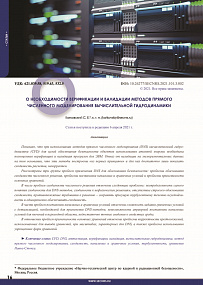Показано, что при использовании методов прямого численного моделирования (DNS) вычислительной гидродинамики (CFD) для целей обоснования безопасности объектов использования атомной энергии необходима полноценная верификация и валидация программ для ЭВМ. Отказ от валидации на экспериментальных данных на том основании, что эти методы построены «из первых принципов» и для них достаточно лишь показать сходимость расчетов, некорректен.
Рассмотрены три группы проблем применения DNS для обоснования безопасности: проблемы обоснования сходимости численного решения, проблемы постановки начальных и граничных условий и проблемы применимости основных уравнений.
В числе проблем сходимости численного решения отмечены следующие проблемы: неопределенность самого понятия сходимости для DNS-методов, сходимость к нефизическим решениям, отсутствие строгого обоснования сходимости, противоположные требования к решению — сохранять присущую турбулентному течению неустойчивость и одновременно обеспечивать сходимость.
В части проблем постановки начальных и граничных условий отмечены сложность задания граничных условий с детализацией, необходимой для применения DNS-методов, невозможность априорной постановки начальных условий для течений в переходной области, недостаточно точные сведения о свойствах среды.
В отношении проблем применимости основных уравнений отмечены проблемы корректности предположений, использованных для вывода уравнений, при масштабах, характерных для DNS, а также проблема использования упрощенных форм уравнений.
Ключевые слова: CFD, DNS, аттестация, верификация, валидация, вычислительная гидродинамика, метод прямого численного моделирования, сходимость, начальные и граничные условия, турбулентность, уравнения Навье-Стокса.
Язык статьи: русский. Сс. 16–25. DOI: 10.26277/SECNRS.2021.101.3.002.
It is shown that computational fluid dynamics (CFD) direct numerical simulation (DNS) codes shall be verified and validated on experimental data to be applicable for safety justification, and that it is not correct to omit experimental data validation appealing to the statement that such methods are based on so-called “first principles” and therefore the simple demonstration of the solution convergence is sufficient for such methods.
The following problem groups of the application of DNS methods to the nuclear safety justification are discussed: the problems of the numeric solution convergence, the initial and boundary conditions problems, and the problems of the applicability of the main equations.
Among the problems of convergence of the numerical solution the following problems are noted: the ambiguity of the concept of convergence applied to the DNS methods, convergence to the non-physical solutions, the lack of the convergence justification, and the opposite requirements for the solution – to maintain the instability inherent in turbulent flow and to ensure convergence.
Among the initial and boundary conditions problems, the following problems are noted: the complexity of setting the boundary conditions with the detail required for using the DNS methods, the impossibility of a priori setting of the initial conditions for the transition flows, and the lack of the accurate information about the medium properties.
In relation to the applicability of the basic equations, the problems of correctness at scales typical for DNS of the assumptions used to derive the main equations and the problem of using simplified forms of equations are noted.
Keywords: CFD, DNS, certification, verification, validation, computational fluid dynamics, direct numerical simulation, convergence, initial and boundary conditions, turbulence, Navier-Stokes equations.
Article language: Russian. Pp. 16–25. DOI: 10.26277/SECNRS.2021.101.3.002.


